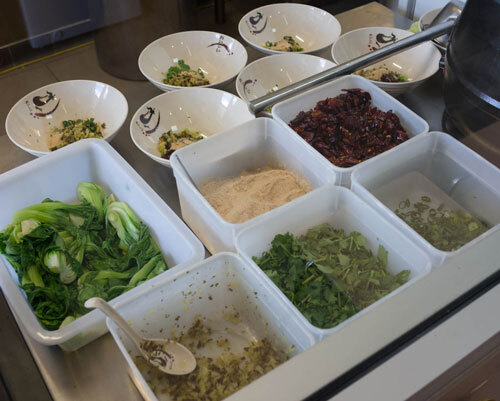
An example of mise en place in action. (Charles Haynes/Flickr)
What we are really talking about when talk about mise en place
With the rise of celebrity chefs and the introduction of cameras into commercial kitchens, the wider audience quickly learned these people and these jobs often suck. Restaurants can be nasty places, not necessarily in the hygienic sense but definitely that too, staffed with people forged in a fire of pettiness and grease. Some people love it, others flee.
The “brigade technique” is often used to justify the verbal, and often physical and worse, abuse that takes place in high pressure kitchens. While the “brigade technique” is supposed to refer to the larger organizational operations that make a restaurant successful, mise en place is how chefs actually get the work done.
To put it simply, it’s kitchen prep. Before you start cooking, even preheating you have your ingredients prepared or at least ready for their inclusion. You organize before you prepare. In a commercial kitchen, this looks like a line station. A place where whatever you need, diced onion, etc, is there waiting for you to use. At home, this looks like a series of bowls. If this seems obvious, well, sure. However, the French took a simple idea and elevated it to an artform worthy of its own elegant phrase.
An NPR article on chefs’ devotion to the practice found that, “… for many culinary professionals, the phrase connotes something deeper. Some cooks call it their religion. It helps them coordinate vast amounts of labor and material, and transforms the lives of its practitioners through focus and self-discipline.”
The article found some chefs with mise en place tattoos and many following the practice in their personal lives. A student at the Culinary Institute of America went so far as to say, “You mise-en-place your life. You set up your books for class, you set up your chef whites, your shoes are shined, you know everything that you need every step of the day.”
This does lead to a bit of a chicken and the egg scenario between the “brigade system” and mise en place. In noting the similarities between the two, NPR found, “Some chefs say that mise-en-place is nothing more than a kitchen version of good old-fashioned military discipline. After all, the rigid culinary hierarchy codified in the 19th century by Georges-Auguste Escoffier is called the “brigade system.”
And this is the problem. The only real source of information about the history of restaurants and kitchen techniques ultimately rely on hearsay from the only people who seem to know. Scholarly work on the history of food, especially restaurants, is almost nonexistent. In the absence of that authority, the closest thing we have gets to write history as it sees fit.
It’s no wonder that restaurant chefs would trace their history to militaries rather than the mothers that likely cooked for them. There is no shortage of articles detailing the difficulties women have in modern kitchens, fine dining or otherwise. The level of abuse anyone faces walking into a kitchen is stunning, but it tends to become especially vicious when directed at female staff. The abuse directed toward men tends to question intelligence or sexuality. I’ve seen otherwise inarticulate men turn into Winston Churchill when yelling at their female counterparts.

The 2017 movie The Founder featured an example of the iconic McDonald’s Speedee System, which is based on mise en place concepts. The McDonald brothers developed the system using chalk on a tennis court.
The “brigade system/technique” and mise en place are but two of the mechanisms that have been used to justify the lack of women in kitchens. The first internationally renowned restaurants were established in a time when women were excluded from most work except a few token fields. The work involved in both systems means routinely having to haul 30 to 50 pounds of prepared meat or vegetables across a busy kitchen packed with people that hate you. Men decided for women that this was no environment for a woman.
Over time, the famed techniques of French kitchens became commonplace everywhere. Even McDonald’s famed “Speedee” system is basically mise en place and the “brigade technique” on steroids. These practices are so revered that changing them is often considered heresy. What is so disingenuous about professional chefs’ claim to military heritage is how terrible military food is, regardless of time or culture. Instances of aristocratic officers eating well are numerous but military food is almost universally, historically, comically terrible.
But more fascinating is watching ratatouille being made. If you haven’t before:
Even a super simplified version of that, like the kind made by “peasants” 60 years before mainstream restaurants developed, would involve a pretty elaborate understanding of mise en place. Though the “peasants” may not have had a phrase for how they made dinner.